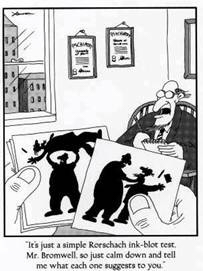|
Psychological TestingPsychological-testing may not be the first subject that springs to mind when you think of forensic psychology, but it's arguably one of the most important topics within the discipline. I've already mentioned that forensic psychology has struggled to establish a clear identity for itself; well there are certain commentators who believe that this situation can be improved by focusing on the role of psychological tests within a forensic context. Testing and the whole notion of individual difference is something that psychology has embraced, investigated and developed throughout its history; and as such, a strong argument exists that it is this ‘branch of applied psychology’ more than any other, which is best placed to champion forensic psychology as a forensic discipline in its own right. Broadly speaking psychological testing can be defined as the use of one or more standardized measurement instruments, devices, or procedures including the use of computerized psychological tests, to observe or record human behavior. This is a useful definition insofar as it highlights the main purpose of psychological testing i.e. to observe or record human behavior, but what it doesn’t do is differentiate between the two main types of testing, namely projective testing and psychometric testing. Two very different types of testing that you need to be aware of. Projective TestingDating back to 1921, the best-known projective psychological test is the Rorschach inkblot test, named after the Swiss psychiatrist Hermann Rorschach. Hermann Rorschach had a great interest in psychoanalysis and in 1918 he began experimenting with inkblots with his own patients. Encouraged by what he found, he published his findings in 1921. Rorschach always cautioned that his findings were preliminary and stressed the importance of much more experimentation; sadly he couldn’t do much of this himself as he died the following year in 1922. Initially Rorschach’s work received little attention but in time his inkblot test became a popular method of psychological evaluation. During the assessment patients are shown a series of inkblots and are asked to to say the first thing that comes to mind. Because the stimulus is ambiguous, it is claimed that the patient must impose his or her own structure and in doing so they reveal their thoughts, feelings, and themes, some of which are unconscious and have been projected into the inkblot image (hence the term projective testing).
Psychometric TestingThe important thing to note about psychometric testing is that it’s governed by 3 key principles: 1. INDIVIDUAL DIFFERENCE To what extent does the individual being tested differ from other individuals in relation to the ability, trait or construct in question? 2. TEMPORAL DIFFERENCE To what extent does the same individual differ in relation to the ability, trait or construct in question when measured on different occasions? 3. STATISTICAL ADHERENCE In order to make an informed judgment about an individual you must have a normative frame of reference in place in order to analyze the test result. Put simply you need a benchmark so that you can compare the test score you’re interested in with the scores obtained from a representative sample. If you’re serious about pursuing a career as a forensic psychologist, there is a very good chance that you will have learn about and become comfortable with the statistical procedures associated with psychometric testing. This statement alone is enough to make most people consider an alternative career path but don’t be phased by the thought of statistics. The principles you need to come to terms (although extending beyond the confines of this discussion) are actually very straight forward. Honest! Psychologists have developed literally hundreds of psychometric tests for a variety of purposes. Achievement and aptitude tests are regularly employed in educational and employment settings, clinical tests assess levels of anxiety and depression, neuropsychological tests measure cognitive functioning e.g. ability to reason, think etc; and then there are the countless tests that attempt to measure every conceivable aspect of a person’s personality. However, in terms of forensic application there is one psychometric test in particular that you need to be aware of. Minnesota Multiphasic Personality Inventory (MMPI)The MMPI was developed by Starke R Hathaway & J Charnley McKinley in the 1930’s and was first published for commercial use in 1942. It was originally designed to aid in the process of psychiatric diagnosis but as it became more and more popular it was increasingly being employed with ‘normal’ populations within work, military and forensic settings. The test consists of 566 items arranged across a number of scales e.g. a depression scale. Each item is presented by way of a statement to which the person being tested responds either true or false. If you were to do a literature search on the MMPI you would find thousands of journal articles relating to its basic and subsidiary scales. These scales have been used in a wide variety of research contexts and many observers began to argue that the MMPI had become a victim of its own success, because it was essentially being used to measure a whole of host of things beyond its original and intended purpose. As a result, the psychometric integrity of the MMPI was questioned. This prompted almost a decade of development work resulting in the publication of the MMPI-2 in 1989. The following quote should give you some idea of the scope of the MMPI and the MMPI-2. The items range widely in content, covering such areas as general health, affective neurological, and motor symptoms; sexual, political and social attitudes; educational, occupational, family and marital questions; and many well known neurotic or psychotic behavior manifestations’. (Anastatsi 1997). Essential Psychological Testing ReadingPsychological Testing by Anna Anastasi and Susana Urbina.
Book Description This classic, authoritative introduction to psychological testing is widely hailed for its broad coverage and its ability to cover "graduate school" topics in terms that one with little testing experience can understand. This book familiarizes the reader with the basics of test construction and prepares the reader to effectively evaluate different tests, choose tests for particular purposes and individual examines, and interpret scores properly. Psychological Testing (7th Edition) Additional Reading: Don't forget to check out the psychological testing and assessment books listed on the forensic psychology books page. See following link. Quality Psychological Testing ResourceThe following link will take you to the psychological testing centre. An extremely useful and thorough resource provided by the British Psychological Society.
Back To Top Of The Page
|

